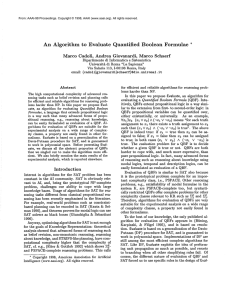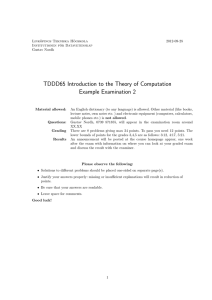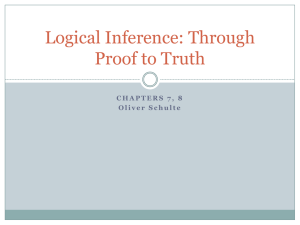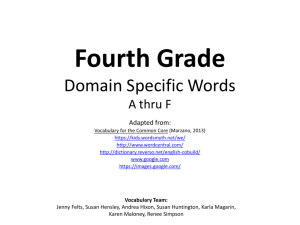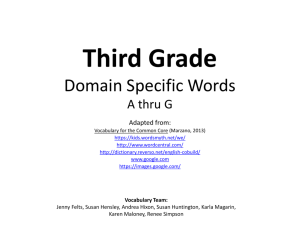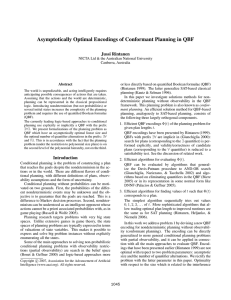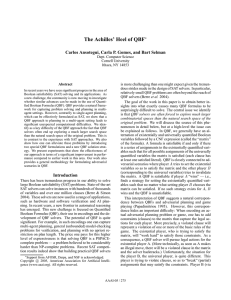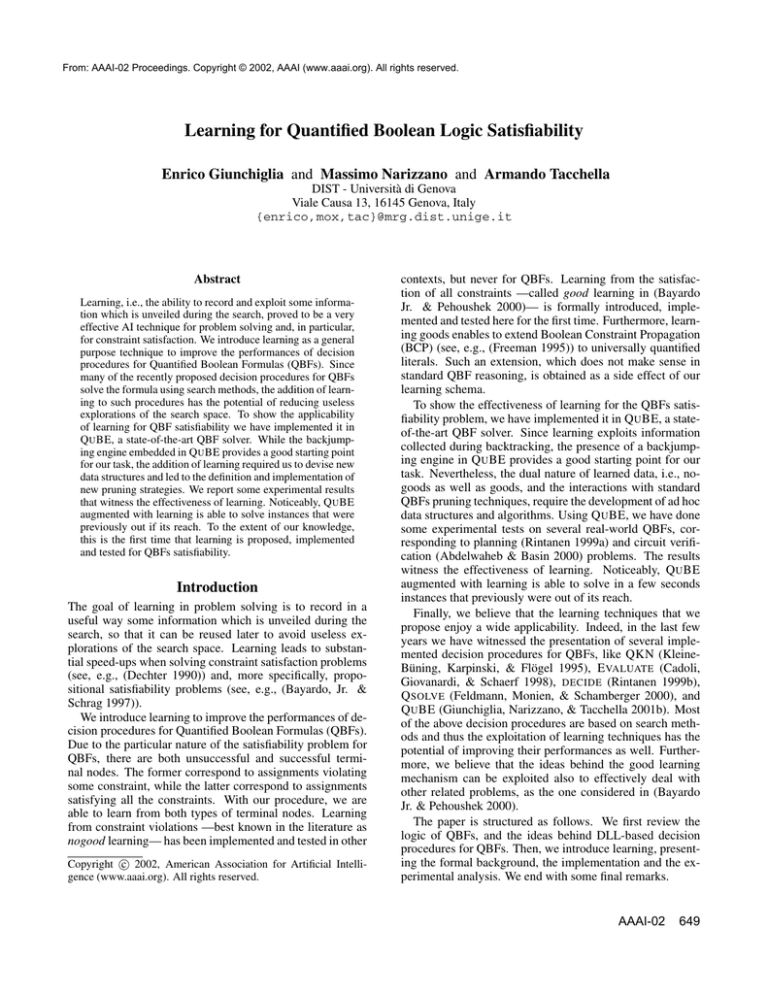
From: AAAI-02 Proceedings. Copyright © 2002, AAAI (www.aaai.org). All rights reserved.
Learning for Quantified Boolean Logic Satisfiability
Enrico Giunchiglia and Massimo Narizzano and Armando Tacchella
DIST - Università di Genova
Viale Causa 13, 16145 Genova, Italy
{enrico,mox,tac}@mrg.dist.unige.it
Abstract
Learning, i.e., the ability to record and exploit some information which is unveiled during the search, proved to be a very
effective AI technique for problem solving and, in particular,
for constraint satisfaction. We introduce learning as a general
purpose technique to improve the performances of decision
procedures for Quantified Boolean Formulas (QBFs). Since
many of the recently proposed decision procedures for QBFs
solve the formula using search methods, the addition of learning to such procedures has the potential of reducing useless
explorations of the search space. To show the applicability
of learning for QBF satisfiability we have implemented it in
Q U BE, a state-of-the-art QBF solver. While the backjumping engine embedded in Q U BE provides a good starting point
for our task, the addition of learning required us to devise new
data structures and led to the definition and implementation of
new pruning strategies. We report some experimental results
that witness the effectiveness of learning. Noticeably, Q U BE
augmented with learning is able to solve instances that were
previously out if its reach. To the extent of our knowledge,
this is the first time that learning is proposed, implemented
and tested for QBFs satisfiability.
Introduction
The goal of learning in problem solving is to record in a
useful way some information which is unveiled during the
search, so that it can be reused later to avoid useless explorations of the search space. Learning leads to substantial speed-ups when solving constraint satisfaction problems
(see, e.g., (Dechter 1990)) and, more specifically, propositional satisfiability problems (see, e.g., (Bayardo, Jr. &
Schrag 1997)).
We introduce learning to improve the performances of decision procedures for Quantified Boolean Formulas (QBFs).
Due to the particular nature of the satisfiability problem for
QBFs, there are both unsuccessful and successful terminal nodes. The former correspond to assignments violating
some constraint, while the latter correspond to assignments
satisfying all the constraints. With our procedure, we are
able to learn from both types of terminal nodes. Learning
from constraint violations —best known in the literature as
nogood learning— has been implemented and tested in other
c 2002, American Association for Artificial IntelliCopyright gence (www.aaai.org). All rights reserved.
contexts, but never for QBFs. Learning from the satisfaction of all constraints —called good learning in (Bayardo
Jr. & Pehoushek 2000)— is formally introduced, implemented and tested here for the first time. Furthermore, learning goods enables to extend Boolean Constraint Propagation
(BCP) (see, e.g., (Freeman 1995)) to universally quantified
literals. Such an extension, which does not make sense in
standard QBF reasoning, is obtained as a side effect of our
learning schema.
To show the effectiveness of learning for the QBFs satisfiability problem, we have implemented it in Q U BE, a stateof-the-art QBF solver. Since learning exploits information
collected during backtracking, the presence of a backjumping engine in Q U BE provides a good starting point for our
task. Nevertheless, the dual nature of learned data, i.e., nogoods as well as goods, and the interactions with standard
QBFs pruning techniques, require the development of ad hoc
data structures and algorithms. Using Q U BE, we have done
some experimental tests on several real-world QBFs, corresponding to planning (Rintanen 1999a) and circuit verification (Abdelwaheb & Basin 2000) problems. The results
witness the effectiveness of learning. Noticeably, Q U BE
augmented with learning is able to solve in a few seconds
instances that previously were out of its reach.
Finally, we believe that the learning techniques that we
propose enjoy a wide applicability. Indeed, in the last few
years we have witnessed the presentation of several implemented decision procedures for QBFs, like QKN (KleineBüning, Karpinski, & Flögel 1995), E VALUATE (Cadoli,
Giovanardi, & Schaerf 1998), DECIDE (Rintanen 1999b),
Q SOLVE (Feldmann, Monien, & Schamberger 2000), and
Q U BE (Giunchiglia, Narizzano, & Tacchella 2001b). Most
of the above decision procedures are based on search methods and thus the exploitation of learning techniques has the
potential of improving their performances as well. Furthermore, we believe that the ideas behind the good learning
mechanism can be exploited also to effectively deal with
other related problems, as the one considered in (Bayardo
Jr. & Pehoushek 2000).
The paper is structured as follows. We first review the
logic of QBFs, and the ideas behind DLL-based decision
procedures for QBFs. Then, we introduce learning, presenting the formal background, the implementation and the experimental analysis. We end with some final remarks.
AAAI-02
649
Quantified Boolean Logic
• The propositional formula {{}} is equivalent to FALSE.
Thus, for example, a typical QBF is the following:
Consider a set P of propositional letters. An atom is an element of P. A literal is an atom or the negation of an atom. In
the following, for any literal l,
∃x∀y∃z∃s{{¬x, ¬y, z}, {x, ¬y, ¬s},
{¬y, ¬z}, {y, z, ¬s}, {z, s}}.
Logic
• |l| is the atom occurring in l; and
• l is ¬l if l is an atom, and is |l| otherwise.
A propositional formula is a combination of atoms using
the k-ary (k ≥ 0) connectives ∧, ∨ and the unary connective
¬. In the following, we use T RUE and FALSE as abbreviations for the empty conjunction and the empty disjunction
respectively.
A QBF is an expression of the form
ϕ = Q1 x1 Q2 x2 . . . Qn xn Φ
(n ≥ 0)
(1)
where
• every Qi (1 ≤ i ≤ n) is a quantifier, either existential ∃
or universal ∀,
• x1 , . . . , xn are pairwise distinct atoms in P, and
• Φ is a propositional formula in the atoms x1 , . . . , xn .
Q1 x1 . . . Qn xn is the prefix and Φ is the matrix of (1). We
also say that a literal l is existential if ∃|l| belongs to the
prefix of (1), and is universal otherwise. Finally, in (1), we
define
• the level of an atom xi , to be 1 + the number of expressions Qj xj Qj+1 xj+1 in the prefix with j ≥ i and
Qj = Qj+1 ;
• the level of a literal l, to be the level of |l|;
• the level of the formula, to be the level of x1 .
The semantics of a QBF ϕ can be defined recursively as
follows. If the prefix is empty, then ϕ’s satisfiability is defined according to the truth tables of propositional logic. If
ϕ is ∃xψ (respectively ∀xψ), ϕ is satisfiable if and only if
ϕx or (respectively and) ϕ¬x are satisfiable. If ϕ = Qxψ is
a QBF and l is a literal, ϕl is the QBF obtained from ψ by
substituting l with T RUE and l with FALSE. It is easy to see
that if ϕ is a QBF without universal quantifiers, the problem
of deciding the satisfiability of ϕ reduces to SAT.
Two QBFs are equivalent if they are either both satisfiable
or both unsatisfiable.
DLL Based Decision Procedures
Consider a QBF (1). From here on, we assume that Φ is in
conjunctive normal form (CNF), i.e., that it is a conjunction
of disjunctions of literals. Using common clause form transformations, it is possible to convert any QBF into an equivalent one meeting the CNF requirement, see, e.g., (Plaisted
& Greenbaum 1986). As standard in propositional satisfiability, we represent Φ as a set of clauses, and assume that
for any two elements l, l in a clause, it is not the case that
l = l . With this notation,
• The empty clause {} stands for FALSE,
• The empty set of clauses {} stands for T RUE,
650
AAAI-02
(2)
In (Cadoli, Giovanardi, & Schaerf 1998), the authors
showed how it is possible to extend DLL in order to decide
satisfiability of ϕ. As in DLL, variables are selected and
are assigned values. The difference wrt DLL is that variables need to be selected taking into account the order in
which they occur in the prefix. More precisely, a variable
can be selected only if all the variables at higher levels have
been already selected and assigned. The other difference is
that backtracking to the last universal variable whose values
have not been both explored occurs when the formula simplifies to T RUE. In the same paper, the authors also showed
how the familiar concepts of “unit” and “monotone” literal
from the SAT literature can be extended to QBFs and used
to prune the search. In details, a literal l is
• unit in (1) if l is existential, and, for some m ≥ 0,
– a clause {l, l1 , . . . , lm } belongs to Φ, and
– each expression ∀|li | (1 ≤ i ≤ m) occurs at the right
of ∃|l| in the prefix of (1).
• monotone if either l is existential [resp. universal], l belongs to some [resp. does not belong to any] clause in
Φ, and l does not belong to any [resp. belongs to some]
clause in Φ.
If a literal l is unit or monotone in Φ, then ϕ is satisfiable
iff ϕl is satisfiable. Early detection and assignment of unit
and monotone literals are fundamental for the effectiveness
of QBF solvers. See (Cadoli, Giovanardi, & Schaerf 1998)
for more details.
A typical computation tree for deciding the satisfiability
of a QBF is represented in Figure 1.
Learning
CBJ and SBJ
The procedure presented in (Cadoli, Giovanardi, & Schaerf
1998) uses a standard backtracking schema. In (Giunchiglia,
Narizzano, & Tacchella 2001b), the authors show how
Conflict-directed Backjumping (CBJ) (Prosser 1993b) can
be extended to QBFs, and introduce the concept of Solutiondirected Backjumping (SBJ). The idea behind both forms of
backjumping is to dynamically compute a subset ν of the
current assignment which is “responsible” for the current result. Intuitively, “responsible” means that flipping the literals not in ν would not change the result. In the following,
we formally introduce these notions to put the discussion on
firm grounds.
Consider a QBF ϕ. A sequence µ = l1 ; . . . ; lm (m ≥ 0)
of literals is an assignment for ϕ if for each literal li in µ
• li is unit, or monotone in ϕl1 ;...;li−1 ; or
• for each atom x at a higher level of li , there is an lj in µ
with j < i and |lj | = x.
For any sequence of literals µ = l1 ; . . . ; lm , ϕµ is the QBF
obtained from ϕ by
ϕ1 : ∃x∀y∃z∃s{{¬x, ¬y, z}, {x, ¬y, ¬s}, {¬y, ¬z}, {y, z, ¬s}, {z, s}}
¬x, L
ϕ2 : ∀y∃z∃s{{¬y, ¬s}, {¬y, ¬z}, {y, z, ¬s}, {z, s}}
¬y, L,z, P
ϕ3 : {}
y, R,¬s, U,¬z, U
ϕ4 : {{}}
x, R
ϕ5 : ∀y∃z∃s{{¬y, z}, {¬y, ¬z}, {y, z, ¬s}, {z, s}}
¬y, L, z, P
ϕ6 : {}
y, R, z, U
ϕ7 : {{}}
Figure 1: A typical computation tree for (2). U, P, L, R stand for UNIT, PURE, L - SPLIT, R - SPLIT respectively, and have the
obvious meaning.
• deleting the clauses in which at least one of the literals in
µ occurs;
• removing li (1 ≤ i ≤ m) from the clauses in the matrix;
and
• deleting |li | (1 ≤ i ≤ m) and its binding quantifier from
the prefix.
For instance, if ϕ is (2) and µ is ¬x, then ϕµ is the formula
ϕ2 in Figure 1.
Consider an assignment µ = l1 ; . . . ; lm for ϕ.
A set of literals ν is a reason for ϕµ result if
• ν ⊆ {l1 , . . . , lm }, and
• for any sequence µ such that
– ν ⊆ {l : l is in µ },
– {|l| : l is in µ } = {|l| : l is in µ},
ϕµ is satisfiable iff ϕµ is satisfiable.
According to previous definitions, e.g., if ϕ is (1) and µ is
¬x; ¬y; z then ϕµ = ϕ3 = {} and {¬y, z} is a reason for
ϕµ result (see Figure 1).
Reasons can be dynamically computed while backtracking, and are used to skip the exploration of useless branches.
In the previous example, the reason {¬y, z} is computed
while backtracking from ϕ3 .
Let ν be a reason for ϕµ result. We say that
• ν is a reason for ϕµ satisfiability if ϕµ is satisfiable, and
• ν is a reason for ϕµ unsatisfiability, otherwise.
See (Giunchiglia, Narizzano, & Tacchella 2001b) for
more details.
Learning
The idea behind learning is simple: reasons computed during the search are stored in order to avoid discovering the
same reasons in different branches. In SAT, the learnt reasons are “nogoods” and can be simply added to the set of
input clauses. In the case of QBFs, the situation is different. Indeed, we have two types of reasons (“good” and “nogood”), and they need different treatments. Further, even
restricting to nogoods, a reason can be added to the set of
input clauses only under certain conditions, as sanctioned
by the following proposition.
Consider a QBF ϕ. We say that an assignment µ =
l1 ; . . . ; lm for ϕ is prefix-closed if for each literal li in µ,
all the variables at higher levels occur in µ.
Proposition 1 Let ϕ be a QBF. Let µ = l1 ; . . . ; lm (m ≥ 0)
be a prefix-closed assignment for ϕ. If ν is a reason for ϕµ
unsatisfiability then ϕ is equivalent to
Q1 x1 . . . Qn xn (Φ ∧ (∨l∈ν l)).
As an application of the above proposition, consider the
QBF ϕ
∃x∀y∃z∃s{{y, z}, {¬y, ¬z, s}, {¬x, z}, {¬y, ¬s}, {y, ¬s}}
We have that ϕ is satisfiable, and
• the sequences x; y; z and x; z; y are prefix-closed assignments for ϕ,
• ϕx;y;z = ϕx;z;y = ∃s{{s}, {¬s}} is unsatisfiable, and
{y, z} is a reason for both ϕx;y;z and ϕx;z;y unsatisfiability,
• we can add {¬y, ¬z} to the matrix of ϕ and obtain an
equivalent formula.
On the other hand, using the same example, we can show
that the requirement that µ be prefix-closed in Proposition 1
cannot be relaxed. In fact, we have that
• the sequence x; z is an assignment for ϕ, but it is not
prefix-closed,
• ϕx;z = ∀y∃s{{¬y, s}, {¬y, ¬s}, {y, ¬s}} is unsatisfiable, and {z} is a reason for ϕx;z unsatisfiability,
• if we add {¬z} to the matrix of ϕ, we obtain an unsatisfiable formula.
Notice that the sequence x; z is a prefix-closed assignment
if we exchange the y with the z quantifiers, i.e.,
∃x∃z∀y∃s{{y, z}, {¬y, ¬z, s}, {¬x, z}, {¬y, ¬s}, {y, ¬s}}.
In the above QBF ϕ, {z} is a reason for ϕx;z unsatisfiability;
we can add {¬z} to the matrix of ϕ; and we can immediately
conclude that ϕ is unsatisfiable.
In the hypotheses of Proposition 1, we say that the clause
(∨l∈ν l) is a nogood. Notice, that if we have only existential
quantifiers —as in SAT— any assignment is prefix-closed,
each reason corresponds to a nogood ν, and ν can be safely
added to (the matrix of) the input formula.
A proposition “symmetric” to Proposition 1 can be stated
for good learning.
Proposition 2 Let ϕ be a QBF. Let µ = l1 ; . . . ; lm (m ≥ 0)
be a prefix-closed assignment for ϕ. If ν is a reason for ϕµ
satisfiability then ϕ is equivalent to
Q1 x1 . . . Qn xn (¬(∨l∈ν l) ∨ Φ).
AAAI-02
651
As before, in the hypotheses of Proposition 2, we say that
the clause (∨l∈ν l) is a good. For example, with reference to
the formula ϕ at the top of Figure 1,
• the assignment ¬x; ¬y; z is prefix-closed,
• ϕ¬x;¬y;z = ϕ3 = {} is satisfiable, and {¬y; z} is a reason
for ϕ¬x;¬y;z satisfiability,
• the clause (y ∨ ¬z) is a good, and its negation can be put
in disjunction with the matrix of ϕ.
An effective implementation of learning requires an efficient handling of goods and nogoods. The situation is more
complicated than in SAT because goods have to be added
as disjunctions to the matrix. However, once we group all
the goods together, we obtain the negation of a formula in
CNF, and ultimately the negation of a set of clauses. The
treatment of nogoods is not different from SAT: we could
simply add them to the matrix. However, since exponentially many reasons can be computed, some form of space
bounding is required. In SAT, the two most popular space
bounded learning schemes are
• size learning of order n (Dechter 1990): a nogood is
stored only if its cardinality is less or equal to n,
• relevance learning of order n (Ginsberg 1993): given a
current assignment µ, a nogood ν is stored as long as the
number of literals in ν and not in µ is less or equal to n.
(See (Bayardo, Jr. & Miranker 1996) for their complexity
analysis). Thus, in size learning, once a nogood is stored,
it is never deleted. In relevance learning, stored nogoods
are dynamically added and deleted depending on the current
assignment.
The above notions of size and relevance learning trivially
extend to QBFs for both goods and nogoods, and we can
take advantage of the fast mechanisms developed in SAT to
efficiently deal with learnt reasons. In practice, we handle
three sets of clauses:
• the set of clauses Ψ corresponding to the goods learnt during the search;
• the set of clauses Φ corresponding to the input QBF; and
• the set of clauses Θ corresponding to the nogoods learnt
during the search.
From a logical point of view, we consider Extended QBFs.
An Extended QBF (EQBF) is an expression of the form
Q1 x1 . . . Qn xn Ψ, Φ, Θ
(n ≥ 0)
(3)
where
• Q1 x1 . . . Qn xn is the prefix and is defined as above, and
• Ψ, Φ and Θ are sets of clauses in the atoms x1 , . . . , xn
such that both
Q1 x1 . . . Qn xn (¬Ψ ∨ Φ)
and
(4)
Q1 x1 . . . Qn xn (Φ ∧ Θ)
(5)
are logically equivalent to (1).
Initially Ψ and Θ are the empty set of clauses, and Φ is the
input set of clauses. As the search proceeds,
652
AAAI-02
• Nogoods are determined while performing CBJ and are
added to Θ; and
• Goods are determined while performing SBJ and are
added to Ψ.
In both cases, the added clauses will be eventually deleted
when performing relevance learning (this is why the clauses
in Θ are kept separated from the clauses in Φ). Notice that
in a nogood C (and in the input clauses as well) the universal literals that occur to the right of all the existential literals
in C can be removed (Kleine-Büning, Karpinski, & Flögel
1995). Analogously, in a good C, the existential literals that
occur to the right of the universal literals in C can be removed.
Notice that the clauses in Ψ have to be interpreted —
because of the negation symbol in front of Ψ in (4)— in
the dual way wrt the clauses in Φ or Θ. For example, an
empty clause in Ψ allows us to conclude that Ψ is equivalent
to FALSE and thus that (1) is equivalent to T RUE. On the
other hand, if Ψ is the empty set of clauses, this does not
give us any information about the satisfiability of Φ.
Because of the clauses in Ψ and Θ the search can be
pruned considerably. Indeed, a terminal node can be anticipated because of the clauses in Ψ or Θ. Further, we can
extend the notion of unit to take into account the clauses in
Ψ and/or Θ. Consider an EQBF (3). A literal l is
• unit in (3) if
– either l is existential, and, for some m ≥ 0,
∗ a clause {l, l1 , . . . , lm } belongs to Φ or Θ, and
∗ each expression ∀|li | (1 ≤ i ≤ m) occurs at the right
of ∃|l| in the prefix of (3).
– or l is universal, and, for some m ≥ 0,
∗ a clause {l, l1 , . . . , lm } belongs to Ψ, and
∗ each expression ∃|li | (1 ≤ i ≤ m) occurs at the right
of ∀|l| in the prefix of (3).
Thus, existential and universal literals can be assigned by
“unit propagation” because of the nogoods and goods stored.
The assignment of universal literals by unit propagation is a
side effect of the good leaning mechanism, and there is no
counterpart in standard QBF reasoning.
To understand the benefits of learning, consider the QBF
(2). The corresponding EQBF is
∃x∀y∃z∃s{}, {{¬x, ¬y, z}, {x, ¬y, ¬s},
{¬y, ¬z}, {y, z, ¬s}, {z, s}}, {}.
(6)
With reference to Figure 1, the search proceeds as in the Figure, with the first branch leading to ϕ3 . Then, given what we
said in the paragraph below Proposition 2, the good {y, ¬z}
(or {y}) is added to the initial EQBF while backtracking
from ϕ3 . As soon as x is flipped,
• y is detected to be unit and consequently assigned; and
• the branch leading to ϕ6 is not explored.
As this example shows, (good) learning can avoid the useless exploration of some branches.
Test File
Adder.2-S
Adder.2-U
B*3i.4.4
B*3ii.4.3
B*3ii.5.2
B*3ii.5.3
B*3iii.4
B*3iii.5
B*4ii.6.3
B*4iii.6
Impl08
Impl10
Impl12
Impl14
Impl16
Impl18
Impl20
L*BWL*A1
L*BWL*B1
C*12v.13
T/F
LV.
T
F
F
F
F
T
F
T
F
F
T
T
T
T
T
T
T
F
F
T
4
3
3
3
3
3
3
3
3
3
17
21
25
29
33
37
41
3
3
3
#∃x
35
44
284
243
278
300
198
252
831
720
26
32
38
44
50
56
62
1098
1870
913
#∀x
16
9
4
4
4
4
4
4
7
7
8
10
12
14
16
18
20
1
1
12
# CL .
109
110
2928
2533
2707
3402
1433
1835
15061
9661
66
82
98
114
130
146
162
62820
178750
4582
TIME - BT
NODES - BT
TIME - BJ
NODES - BJ
TIME - LN
NODES - LN
0.03
2.28
> 1200
> 1200
> 1200
> 1200
> 1200
> 1200
> 1200
> 1200
0.08
0.60
4.49
33.22
245.52
> 1200
> 1200
> 1200
> 1200
0.20
1707
150969
–
–
–
–
–
–
–
–
12509
93854
698411
5174804
38253737
–
–
–
–
4119
0.04
0.49
> 1200
2.28
52.47
> 1200
0.56
> 1200
> 1200
> 1200
0.03
0.20
1.15
6.72
39.03
227.45
> 1200
224.57
> 1200
0.23
1643
20256
–
59390
525490
–
18952
–
–
–
3998
22626
127770
721338
4072402
22991578
–
265610
–
4119
0.10
0.20
0.07
0.04
1.59
203.25
0.04
1.83
176.21
65.63
0.00
0.01
0.00
0.00
0.00
0.01
0.01
21.63
57.44
8.11
1715
1236
903
868
3462
39920
807
11743
53319
156896
65
96
133
176
225
280
341
20000
34355
4383
Table 1: Q U BE results on 20 structured problems. Names have been abbreviated to fit into the table.
Implementation and Experimental Analysis
In implementing the above ideas, the main difficulty that has
to be faced is caused by the unit and monotone pruning rules.
Because of them, many assignments are not prefix-closed
and thus the corresponding reasons, according to Propositions 1 and 2, cannot be stored in form of goods or nogoods.
One obvious solution is to enable the storing only when the
current assignment is prefix-closed. Unfortunately, it may
be the case that the assignment is not prefix-closed because
of a literal at its beginning. In these cases, learning would
give no or little benefits. The other obvious solution is to allow the generation of prefix-closed assignments only. This
implies that unit and monotone literals get no longer propagated as soon as they are detected, but only when the atoms
at higher levels are assigned. This solution may cause a dramatic worsening of the performances of the QBF solver.
A closer analysis to the problem, reveals that troubles
arise when backtrack occurs on a literal l, and in the reason for the current result there is a “problematic” literal l
whose level is minor than the level of l. Indeed, if this is the
case, the assignment resulting after the backtracking will not
be prefix-closed. To get rid of each of these literals l , we
substitute l with the already computed reason for rejecting
l . The result may still contain “problematic” literals (these
literals may have been introduced in the reason during the
substitution process), and we go on substituting them till no
one is left. Intuitively, in each branch we are computing the
reasons corresponding to the assignment in which the “problematic” literals are moved to the end of the assignment.
We have implemented the above ideas in Q U BE, together
with a relevance learning scheme. Q U BE is a state-of-theart QBF solver (Giunchiglia, Narizzano, & Tacchella 2001b;
2001a). To test the effectiveness of learning, we considered the structured examples available at www.mrg.dist.
unige.it/qbflib. This test-set consists of structured
QBFs corresponding to planning problems (Rintanen 1999a)
and formal verification problems (Abdelwaheb & Basin
2000). The results on 20 instances are summarized in Table 1. In the Table:
• T / F indicates whether the QBF is satisfiable (T) or not (F),
• LV. indicates the level of the formula,
• #∃x (resp. #∀x) shows the number of existentially (resp.
universally) bounded variables,
• #CL . is the number of clauses in the matrix,
• TIME - BT/NODES - BT (resp. TIME - BJ/NODES - BJ, resp.
TIME - LN / NODES - LN ) is the CPU time in seconds and
number of branches of Q U BE-BT (resp. Q U BE-BJ,
resp. Q U BE-LN). Q U BE-BT, Q U BE-BJ, Q U BE-LN
are Q U BE with standard backtracking; with SBJ and CBJ
enabled; with SBJ, CBJ and learning of order 4 enabled,
respectively.
The tests have been run on a network of identical Pentium
III, 600MHz, 128MB RAM, running SUSE Linux ver. 6.2.
The time-limit is fixed to 1200s. The heuristic used for literal selection is the one described in (Feldmann, Monien, &
Schamberger 2000).
The first observation is that Q U BE-LN, on average, produces a dramatic reduction in the number of branching
nodes. In some cases, Q U BE-LN does less than 0.1% of the
branching nodes of Q U BE-BJ and Q U BE-BT. However, in
general, Q U BE-LN is not ensured to perform less branching nodes than Q U BE-BJ. Early termination or pruning may
prevent the computation along a branch whose reason can
enable a “long backjump” in the search stack, see (Prosser
1993a). For the same reason, there is no guarantee that
by increasing the learning order, we get a reduction in the
number of branching nodes. For example, on L*BWL*B1,
AAAI-02
653
Q U BE-LN branching nodes are 45595, 34355 and 55509 if
run with learning order 2, 4 and 6 respectively. In terms of
speed, learning may lead to very substantial improvements.
The first observation is that Q U BE-LN is able to solve 7
more examples than Q U BE-BJ, and 12 more than Q U BEBT. Even more, some examples which are not solved in the
time-limit by Q U BE-BJ and Q U BE-BT, are solved in less
than 1s by Q U BE-LN. However, learning does not always
pay-off. To have an idea of the learning overhead, consider
the results on the C*12v.13 example, shown last in the table. This benchmark is peculiar because backjumping plays
no role, i.e., Q U BE-BT and Q U BE-BJ perform the same
number of branching nodes.1 On this example, Q U BE-LN
performs more branching node than Q U BE-BJ. These extra
branching nodes of Q U BE-LN are not due to a missed “long
backjump”. Instead, they are due to the fact that Q U BE-BT
and Q U BE-BJ skip the branch on a variable when it does
not occur in the matrix of the current QBF, while Q U BE-LN
takes into account also the databases of the learnt clauses.
The table above shows Q U BE-LN performances with relevance learning of order 4. Indeed, by changing the learning
order we may get completely different figures. For example,
on L*BWL*B1, Q U BE-LN running times are 95.54, 57.44
and 112.73s with learning order 2, 4 and 6 respectively. We
do not have a general rule for choosing the best learning order. According to the experiments we have done, 4 seems to
be a good choice.
Conclusions
In the paper we have shown that it is possible to generalize
nogood learning to deal with QBFs. We have introduced and
implemented good learning. As we have seen, the interactions between nogood/good learning and the unit/monotone
pruning heuristic is not trivial. We have implemented both
nogood and good learning in Q U BE, together with a relevance learning scheme for limiting the size of the learned
clauses database. The experimental evaluation shows that
very substantial speed-ups can be obtained. It also shows
that learning has some overhead. However, we believe that
such overhead can be greatly reduced extending ideas presented in (Moskewicz et al. 2001) for SAT. In particular,
the extension of the “two literal watching” idea, originally
due to (Zhang & Stickel 1996), seems a promising direction. This will be the subject of future research. Finally,
we believe that the learning techniques that we propose can
be successfully integrated in other QBFs solvers, and that
similar ideas can be exploited to effectively deal with other
related problems, such as the one considered in (Bayardo Jr.
& Pehoushek 2000).
We have also tested Q U BE-LN on more than 120000 randomly generated problems for checking the correctness and
robustness of the implementation. These tests have been
generated according to the “model A” described in (Gent &
Walsh 1999). The results will be the subject of a future paper. Q U BE-LN is publicly available on the web.
1
In SAT, this happens for randomly generated problems.
654
AAAI-02
References
Abdelwaheb, A., and Basin, D. 2000. Bounded model construction for monadic second-order logics. In Proc. CAV,
99–113.
Bayardo, Jr., R. J., and Miranker, D. P. 1996. A complexity analysis of space-bounded learning algorithms for the
constraint satisfaction problem. In Proc. AAAI, 298–304.
Bayardo Jr., R. J., and Pehoushek, J. D. 2000. Counting
models using connected components. In Proc. AAAI.
Bayardo, Jr., R. J., and Schrag, R. C. 1997. Using CSP
look-back techniques to solve real-world SAT instances. In
Proc. AAAI, 203–208.
Cadoli, M.; Giovanardi, A.; and Schaerf, M. 1998. An
algorithm to evaluate QBFs. In Proc. AAAI.
Dechter, R. 1990. Enhancement schemes for constraint
processing: Backjumping, learning, and cutset decomposition. Artificial Intelligence 41(3):273–312.
Feldmann, R.; Monien, B.; and Schamberger, S. 2000. A
distributed algorithm to evaluate quantified boolean formulae. In Proc. AAAI.
Freeman, J. W. 1995. Improvements to propositional satisfiability search algorithms. Ph.D. Dissertation, University
of Pennsylvania.
Gent, I., and Walsh, T. 1999. Beyond NP: the QSAT phase
transition. In Proc. AAAI, 648–653.
Ginsberg, M. L. 1993. Dynamic backtracking. Journal of
Artificial Intelligence Research 1:25–46.
Giunchiglia, E.; Narizzano, M.; and Tacchella, A. 2001a.
An analysis of backjumping and trivial truth in quantified
boolean formulas satisfiability. In Proc. AI*IA, LNAI 2175.
Giunchiglia, E.; Narizzano, M.; and Tacchella, A. 2001b.
Backjumping for quantified boolean logic satisfiability. In
Proc. IJCAI, 275–281.
Kleine-Büning, H.; Karpinski, M.; and Flögel, A. 1995.
Resolution for quantified boolean formulas. Information
and computation 117(1):12–18.
Moskewicz, M. W.; Madigan, C. F.; Zhao, Y.; Zhang, L.;
and Malik, S. 2001. Chaff: Engineering an Efficient SAT
Solver. In Proc. DAC.
Plaisted, D., and Greenbaum, S. 1986. A Structurepreserving Clause Form Translation. Journal of Symbolic
Computation 2:293–304.
Prosser, P. 1993a. Domain filtering can degrade intelligent
backjumping search. In Proc. IJCAI, 262–267.
Prosser, P. 1993b. Hybrid algorithms for the constraint satisfaction problem. Computational Intelligence 9(3):268–
299.
Rintanen, J. 1999a. Constructing conditional plans by a
theorem prover. Journal of Artificial Intelligence Research
10:323–352.
Rintanen, J. 1999b. Improvements to the evaluation of
quantified boolean formulae. In Proc. IJCAI, 1192–1197.
Zhang, H., and Stickel, M. E. 1996. An efficient algorithm
for unit propagation. In Proc. of the 4th International Symposium on Artificial Intelligence and Mathematics.




